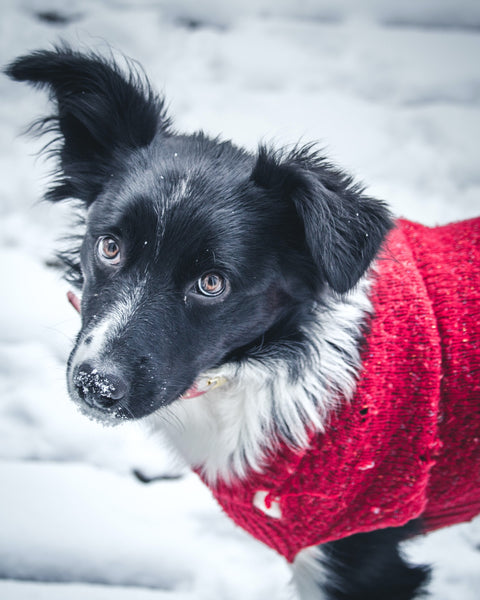Your dog may have a soft, furry coat, but that doesn’t necessarily mean that he’s exempt from “sweater weather.” While it’s true that many canine coats act as built-in climate control, your pup may need some extra protection when it comes to cold weather.
One of the most important things to keep in mind this winter is that if it’s too cold for you to stand outside and feel comfortable, it’s probably too cold for your dog. That said, it’s not exactly realistic to plan on keeping your pooch inside until spring. As you and your furry friend brave the winter months together, it’s important to understand the telltale signs of a cold dog and crucial winter safety tips.
Signs Your Dog is Cold
If you aren’t paying close attention, cold weather can quickly become dangerous for your dog. As soon as you notice that your dog is feeling cold and uncomfortable, take action to avoid any weather-related illnesses or injuries.
Common signs of a cold dog include:
- Shivering
- Cold ears—fur may keep the body feeling warm to the touch, so if you’re not sure if your dog is cold, check his ears.
- Seeking shelter, such as hiding behind or underneath objects or even attempting to burrow
- Curling up or hunching over
- Limping or holding up paws
- Slow movements or reluctance to walk
- Whining/vocalizing
- Seeming agitated, anxious, or stressed
- Seeming sleepy or lethargic—clumsiness can also be a sign of concern.
If you notice any of the above signs, bring your dog inside to the warmth as soon as possible. You may even want to offer him a blanket and some cozy cuddles to help him warm up faster.
If you’re concerned about your dog’s appearance or behavior after spending time in the cold, it’s never a bad idea to contact your vet to rule out weather-related health issues.

How to Keep Your Dog Warm
Some dogs love to romp around in the snow; some just reluctantly brave the cold for their daily walks and potty breaks. Regardless of how your dog feels about the cold, it’s important to make sure he’s safe and warm during the winter months.
For starters, consider any factors that may affect your dog’s temperature, such as his breed. Does he have a thick coat to help him withstand cold weather, or does he have a thinner coat meant for warmer weather?
Age and health are factors, too—older dogs tend to have a harder time regulating their temperature, as do dogs who are immunocompromised. If you have a puppy or shorter adult dog, be aware that his tummy is more likely to come in contact with the snow, which could speed up the process of getting cold.
Of course, this isn’t to say that you should skip your dog’s daily walks and bathroom breaks if he’s susceptible to the cold. It just means that depending on your dog and his needs, it may be a good idea to suit him up with a sweater and booties before heading out to brave the elements. You should also keep an extra close eye on your pet, monitoring for any signs of a cold dog.
When you can, limit your time outdoors. Your regular walks and play sessions are generally fine, but it’s best not to leave your dog outside alone when the temperatures drop. On extremely cold days, you may want to get creative by exercising your dog indoors.
Try to plan your outside time for when the sun is at its peak, so you and your pup can soak up as much warmth as possible. Physical activity can also generate body heat, so keep your dog active when you’re outside.
Additionally, try your best to keep your dog dry. If he rolls around in the snow, you probably want to play it safe and think about heading inside shortly after the fact.
For some extra warmth, put a towel or blanket in the dryer before you head outside. That way, you can wrap your dog in something warm and cozy as soon as you get home.
Additional Winter Tips for Dogs
It’s also important to make sure your pup is safe and warm when he’s indoors, too. Provide him with a warm place to sleep off of the floor and away from drafts (but away from a space heater), with plenty of cozy bedding to cuddle up in. Some pet owners opt for heated blankets or dog heating pads, but be cautious as these could be safety hazards.
When you head outside, avoid the garage or any areas with antifreeze on the ground. You don’t want your pooch licking up anything toxic! Similarly, be sure to wipe Fido’s paws after you come inside to remove any ice, salt, or dangerous chemicals that he may lick off later.
Winter weather is notorious for causing itchy, flaking skin for humans and dogs alike. To protect your pup’s skin, minimize baths during the colder months and keep your home humidified.
Additionally, dogs tend to burn extra energy in the winter as their bodies are working hard to regulate their temperature. As a result, you may want to feed your pooch a little bit more than usual during these months. Of course, it’s always a good idea to talk to your vet before making any significant changes to your dog’s diet.
Support your dog’s skin and coat, digestion, joint health, and immunity with PetHonesty’s 10-for-1 Multivitamin. These tasty chews combine a well-rounded blend of natural ingredients to promote your dog’s overall health year-round.
Sources:
https://topdogtips.com/how-to-tell-if-your-dog-is-cold/
https://www.rover.com/blog/dog-warm-enough/
https://pets.webmd.com/dogs/features/dog-cold-weather-tips
https://www.aspca.org/pet-care/general-pet-care/cold-weather-safety-tips













